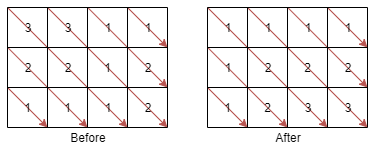QUESTION:
A matrix diagonal is a diagonal line of cells starting from some cell in either the topmost row or leftmost column and going in the bottom-right direction until reaching the matrix’s end. For example, the matrix diagonal starting from mat[2][0], where mat is a 6 x 3 matrix, includes cells mat[2][0], mat[3][1], and mat[4][2].
Given an m x n matrix mat of integers, sort each matrix diagonal in ascending order and return the resulting matrix.
Example 1:

Input: mat = [[3,3,1,1],[2,2,1,2],[1,1,1,2]]
Output: [[1,1,1,1],[1,2,2,2],[1,2,3,3]]
Example 2:
Input: mat = [[11,25,66,1,69,7],[23,55,17,45,15,52],[75,31,36,44,58,8],[22,27,33,25,68,4],[84,28,14,11,5,50]]
Output: [[5,17,4,1,52,7],[11,11,25,45,8,69],[14,23,25,44,58,15],[22,27,31,36,50,66],[84,28,75,33,55,68]]
EXPLANATION:
这道题目简单的逻辑就是:
- 斜着取出数字
- 将数字排序
- 再斜着放入
那么第一步斜着取出数字可以再拆分:
- m就是列, n是行. 确保两者的安全边界
- m++,n++ 取出所有数字
排序就不用说了
再按照同样的顺序放入mat中即可.
SOLUTION:
class Solution {
fun diagonalSort(mat: Array<IntArray>): Array<IntArray> {
for (i in mat[0].size-1 downTo 0) {
var tmp = ArrayList<Int>()
var m = i
var n = 0
while (m <= mat[0].size-1 && n<=mat.size-1) {
tmp.add(mat[n][m])
m++
n++
}
Collections.sort(tmp)
var index = 0
n = 0
m = i
while (m <=mat[0].size-1 && n<=mat.size-1) {
mat[n][m] = tmp.get(index)
index++
m++
n++
}
}
for (i in 0..mat.size-1) {
var tmp = ArrayList<Int>()
var m = 0
var n = i
while (m<=mat[0].size-1 && n<=mat.size-1) {
tmp.add(mat[n][m])
m++
n++
}
Collections.sort(tmp)
var index = 0
m = 0
n = i
while (m <=mat[0].size-1 && n<=mat.size-1) {
mat[n][m] = tmp.get(index)
index++
m++
n++
}
}
return mat
}
}